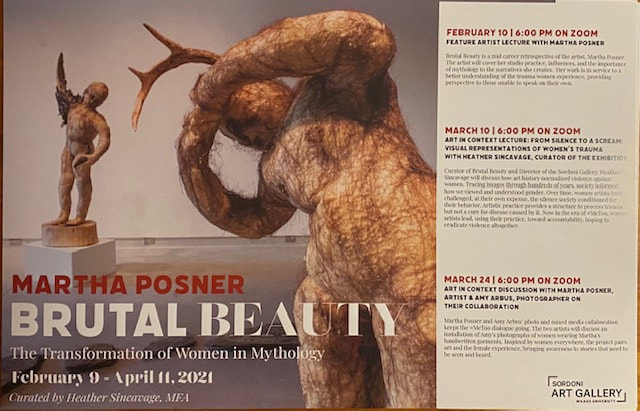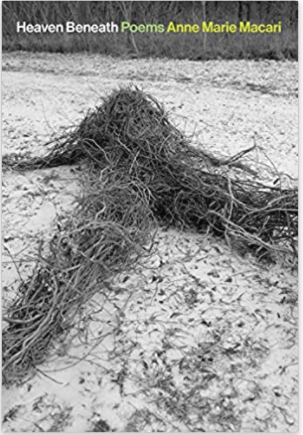|
6/28/2024 0 Comments Larry fink / Martha Posner: Flesh and Bone Sarasota Art museum November 17, 2024 - April 13, 2025
0 Comments
12/22/2022 0 Comments Martha Posner at Stirner Modern through February 2023. ARTIST'S TALK JANUARY 7, 2023 @ 12NOON.For MOre information: www.stirnermodern.comTo register for any of the events below or for more information, please contact:
Karley Stasko SAG Outreach Coordinator [email protected] "From Silence to a Scream: The Visual Representation of Women’s Trauma" An "Art in Context Lecture March 10 | 6 p.m. on Zoom With Heather Sincavage, MFA, Exhibition CuratorAs a rule, visual art movements mirror societal attitudes, whether it be the anxiety of war,economic strife, or civil unrest. Even as artists push new ideas to the forefront, they cannot help but reflect the times. For centuries, women were subjects to be depicted, seldom the ones to speak and be heard. Because of this, gender roles depicted in artwork were images a woman should model oneself after, and the creators of such images were almost exclusively men. Curator of Brutal Beauty and Director of the Sordoni Gallery, Heather Sincavage will discuss how art history normalized violence against women. Tracing images through hundreds of years, society informed how we viewed and understood gender. Over time, women artists have challenged, at their own expense, the silence society conditioned for their behavior. Artistic practice provides a structure to process trauma but not a cure for disease caused by it. Now in the era of #MeToo, women artists lead, using their practice, toward accountability, hoping to eradicate violence altogether. "Art in Context" Discussion Featuring Martha Posner, artist, & Amy Arbus, photographer on their collaboration March 24 | 6 p.m. on ZoomMartha Posner and Amy Arbus’ photo and mixed media collaboration keeps the #MeToo dialogue going. The two artists will discuss an installation of Amy's photographs of women wearing Martha's handwritten garments. Inspired by women everywhere, the project pairs art and the female experience, bringing awareness to stories that need to be seen and heard. Amy Arbus is a native New Yorker known for her style feature, On The Street, which ran in The Village Voice from 1980-1990. Her photographs have been published in her five books and in hundreds of periodicals such as New York Magazine, The New Yorker, Aperture and The New York Times Magazine. Her photographs are in the collections of The National Theater in Norway, The Museum of Modern Art, The New York Public Library and The Metropolitan Museum of Art. 12/15/2020 1 Comment Artwork featured on the cover of Anne Marie Macari's latest book of Poems: Heaven BeneathFrom Anne Marie Macari, author of Red Deer, comes a staggering collection of loss and love in the age of Anthropocene―heartbreaking poems rooted in the primordial, the elemental, and the communal. cover artwork by Martha Posner.Brutal Beauty, curated by Heather Sincavage opens at the Sordoni Art Gallery, part of Wilkes University, February 2021. Upcoming Artist talk in June 2021. Details to follow. 2/28/2020 0 Comments My work is included in the seeme 2020 s/he Persisted march 4th - March 26th at the ARmoryExcited to be a part of the upcoming NYC Armory week, My work is included in SeeMe will celebrate Women - Persistence, Power, and Strength.
We will be showcasing the work of many amazing artists from our community from March 4th - March 26th, 2020. For the opening night RSVP using this link: https://www.eventbrite.com/e/seeme-art-takes-armory-she-persisted-exhibition-opening-reception-tickets-97200630703 We are extremely grateful to our partners Bandit Coffee and Anoko House for helping to make this possible, follow them at: https://www.thebandit.com and https://www.instagram.com/anokohouse/ 9/16/2019 0 Comments What we carry by Amy Touchette“Once I started, I couldn’t stop,” Martha Posner remarked. Ironically, the sheer power and pervasiveness of sexual harassment had kept it from rising to the surface, personally, for the artist. Despite spending decades creating paintings and sculptures that emanated from women’s inequality, sublimation, and abuse, there that pain sat, dormant, pushed aside, swallowed, even forgotten, “or whatever it is that we do with the things that we really don’t want,” Posner said. “And then it all came flooding out of me.”
It was a watershed moment. The Harvey Weinstein case had just broken, and, like Posner, many women were beginning to talk about the unspeakable. In a possessed, trance-like state, she began handwriting “me too” over, and over, and over again on secondhand slips and bed-jacket linings. More empowering than cathartic, Posner divined the psychic energy and memories of the previous garment owners as a way of proclaiming and releasing what had, for too long, been hidden, buried beneath layers of clothing, anguish, sorrow, anger, and despair. Posner’s story, she realized, was every woman’s story. The profundity of the outpour immediately struck an emotional chord with photographer Amy Arbus. “When I saw Martha’s garments, my heart stopped for a minute.” Arbus had recently abandoned Goddesses, a photography project portraying women in vintage nightgowns and lingerie that celebrated the vulnerability, strength, and overall complex nature of women—a subject she had yet to tackle during her prolific career, despite having been raised by four formidable women herself. In the end, Arbus felt the series was missing something essential, an underlying thread that connected her subjects, so she reluctantly shelved it. But the fact that she and Posner, long-time friends and colleagues, were simultaneously utilizing intimate secondhand garments was not lost on her—nor was the way in which Posner processed and transformed women’s pain into a symbolic collective of beauty and perseverance. Within days, they began planning their collaboration. Two months later, on January 20, 2019, on a closed set in Easton, Pennsylvania, Arbus photographed 19 subjects in Posner’s garments. Neither were prepared for the emotional intensity that would envelop that day. Both Posner and Arbus cast the shoot with women of diverse sizes, shapes, ages, and ethnicities, the majority of whom they didn’t know personally or whether they’d had a “me too” experience. “We were choosing anyone on the theory that almost everybody has a story,” Arbus explained, “and that was true in this case. You could see that 17 out of the 19 women had one. It was just painfully obvious. It just registered on their faces.” At the same time, Arbus’s subjects were grappling with another dynamic of sexuality on set. Clad only in a slip, the insecurity many of the women felt about their bodies and how they compared to others was palpable—something that echoed Arbus’s own experience and struggle from a young age. “The pressure to be an object of desire is so intense for women in this culture. It’s so ingrained, it’s almost like nature, not nurture, because it’s the way we’re brought up. It’s inextricable from behavior. I didn’t want anyone to feel that they were less beautiful because there was someone else in the room who was a traditional knockout.” It was an exercise in fortitude, and their ability to push forward through it, together, further cemented their bond and the impact of the installation that would ultimately result. Aside from helping cast and set up the logistics of the shoot, Posner was deliberately hands-off that day: “I respect Amy and I like her work very much, but even more important than that, I trust Amy. I trusted her with my work, and I also believed enough in my work to release it to someone else to bring their vision.” What resulted are 14 emotionally charged portraits, several of which were expressly printed to portray the women in a larger-than-life scale. “These women are survivors,” Arbus said. “Life is tough for everybody. I don’t mean that life isn’t tough for men. But these women know how to make it on their own.” Posner had always viewed her garments as an invitation for collaboration. Unlike her past projects that involved clothing, these slips and bed coats are actually wearable. Seeing women from today clad in undercover apparel of another woman’s buried personal memories brought the project, in Posner’s mind, to its full fruition. “It wasn’t just a collaboration between Amy and me. It was collaborative between all of the women who were involved,” said Posner. “You walk by people all the time and you never know what they’re carrying.” |
|







